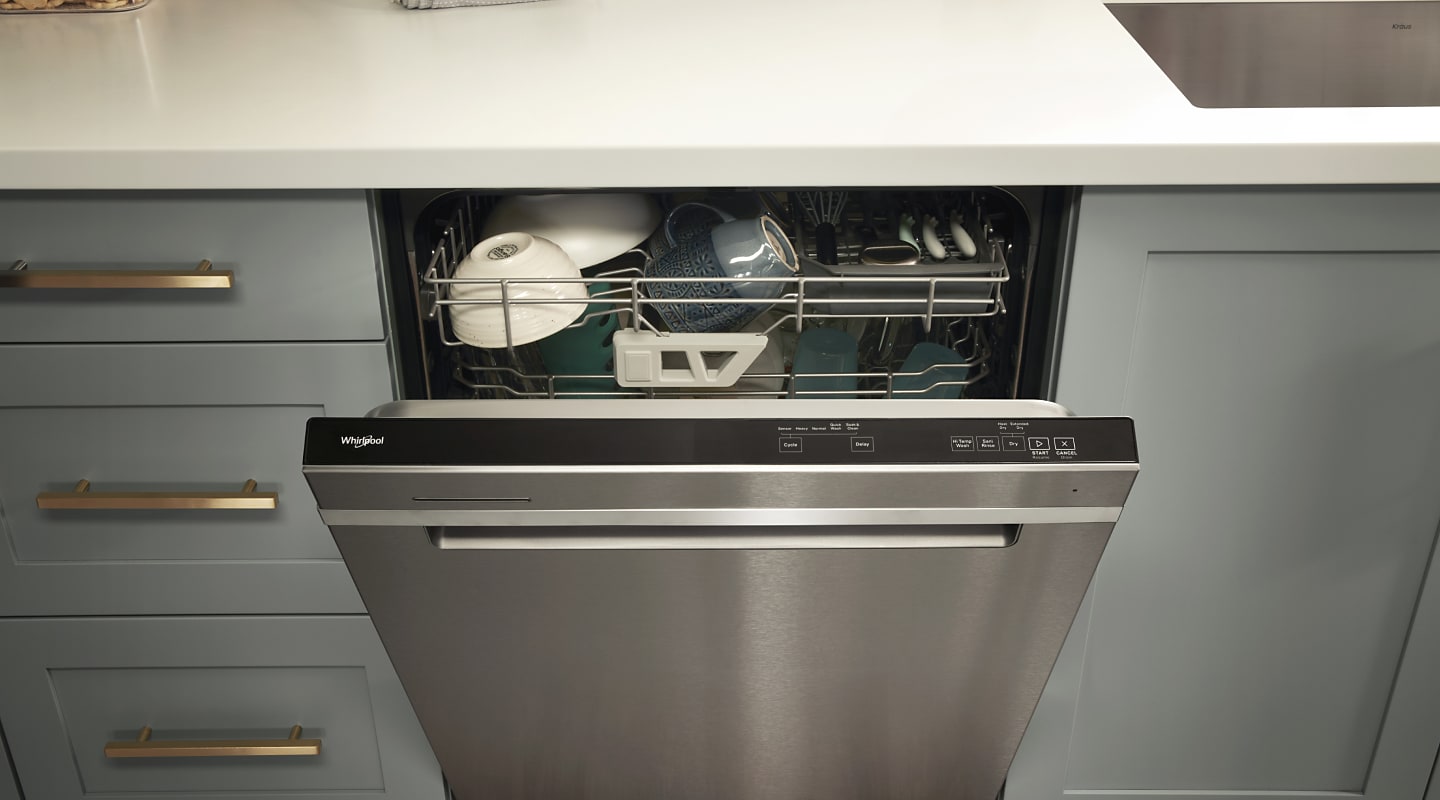Is your dishwasher door giving you trouble? You’re not alone.
A malfunctioning dishwasher door can be a real headache, especially when you’re in the middle of cleaning up after a big meal. When your dishwasher door refuses to close properly, it disrupts your routine and can lead to bigger problems if not addressed.
But don’t worry—there are solutions. We’ll explore the common reasons why your dishwasher door might be acting up and how you can fix it without breaking the bank. Whether it’s a simple misalignment or a worn-out latch, knowing what to look for and how to tackle the issue will save you time and stress. Keep reading to discover how you can get your dishwasher back to working smoothly, ensuring your kitchen remains a hub of efficiency.

Credit: www.youtube.com
Common Causes
Experiencing issues with your dishwasher door not closing properly can be frustrating. Understanding the common causes can help you fix the problem quickly. This guide will discuss some typical reasons for door closure issues.
Misaligned Door
A misaligned door is a frequent issue with dishwashers. Over time, wear and tear can shift the door out of place. This misalignment prevents it from sealing correctly. Check the hinges for any signs of bending or damage. Adjustments can often resolve this problem and improve door alignment.
Damaged Latch
The latch is crucial for keeping the door closed during operation. A damaged latch may cause the door to pop open. Inspect the latch for visible damage. It may be bent, broken, or worn out. Replacing the latch can restore the door’s functionality. This task is usually straightforward and cost-effective.
Obstructions
Sometimes, objects obstruct the door from closing properly. Items like utensils or large pots can block the door’s path. Check for any items protruding from the racks. Ensure that dishes are arranged correctly. A clear path is necessary for the door to close tightly.

Credit: www.whirlpool.com
Tools You May Need
Your dishwasher door is refusing to close properly, and you might be wondering what you can do about it. Before you dive into fixing the issue, it’s essential to have the right tools at hand. Having the right tools not only makes the job easier but also ensures you don’t accidentally damage your appliance further. Let’s explore some tools you may need to tackle this problem.
Screwdrivers
Screwdrivers are a staple in any repair toolkit. You might need a Phillips or flathead screwdriver, depending on the screws used in your dishwasher’s design. Check your dishwasher manual for specifics on the type of screws involved.
Having a set with multiple sizes is beneficial. You don’t want to be halfway through the task only to find your screwdriver is too big or too small. Picture yourself ready to remove a panel, only to realize your screwdriver is incompatible. Frustrating, right?
Another tip: magnetized screwdrivers can save you time and effort. They help keep screws from slipping away, especially in awkward spaces. How many times have you dropped a screw behind a counter, never to see it again?
Replacement Parts
Sometimes, the problem with your dishwasher door might be a faulty latch or hinge. Having replacement parts ready can be a game-changer. It’s like having the missing puzzle piece that completes the picture.
Don’t guess; check the model number of your dishwasher and order parts that fit precisely. Imagine going through the effort of installing a new part only to find it doesn’t fit. That’s why precision is key.
Online stores often offer diagrams and compatibility information to help ensure you pick the right part. Have you ever tried to match shades of paint in a store? It’s similar – getting the wrong part can lead to mismatches and further issues.
What tools have saved you during a home repair? Share your insights below, and let’s learn from each other’s experiences!
Inspection Steps
Ensure the dishwasher is on level ground to prevent door misalignment. Check for obstructions like dishes or debris. Inspect the door latch for damage or wear. Adjust the door hinges if needed. Verify the door seal is intact. Tighten any loose screws to secure the door properly.
If your dishwasher door is not closing properly, frustration can build. A dishwasher with a faulty door can cause leaks and poor cleaning performance. Understanding the root of the issue requires a systematic inspection. Below are key steps to help you troubleshoot the problem.Check Alignment
Begin by inspecting the door alignment. Look at the door when it’s closed. Is it level with the dishwasher frame? An uneven door indicates misalignment. Ensure the dishwasher sits evenly on the floor. Adjust the feet if necessary. This can help realign the door properly.Examine Latch
The latch plays a crucial role in door closure. Check if the latch is damaged or worn out. A malfunctioning latch prevents the door from staying shut. Clean the latch area for any grime or debris. Ensure it moves smoothly without obstruction. Replace the latch if it’s faulty.Clear Obstructions
Obstructions often cause the door not to close. Inspect the area around the door seal. Look for food particles or debris lodged in the door track. Remove any foreign objects that might block closure. Check inside the dishwasher for protruding racks or utensils. Adjust them to ensure the door closes smoothly.Quick Adjustment Techniques
Is your dishwasher door refusing to close? This problem can be frustrating. Quick adjustment techniques can help solve this issue. These techniques are simple and effective. They require minimal tools and time. Follow these steps to get your dishwasher back in working order.
Realign The Door
Sometimes, the door may be misaligned. This can prevent it from closing. Check the hinges first. They should be straight and even. If they are not, gently adjust them. Use a screwdriver if needed. Ensure the door fits snugly into its frame. A properly aligned door will close smoothly.
Tighten Loose Screws
Loose screws can cause the door to hang improperly. Inspect the screws around the door. Focus on those near the hinges. Use a screwdriver to tighten them. Make sure all screws are secure. This will help the door close properly. A few turns can make a big difference.
Replacing Faulty Parts
A dishwasher door not closing properly often means faulty parts. Common culprits include damaged door latches, hinges, or seals. Replacing these parts can ensure a tight seal, preventing leaks and ensuring the dishwasher functions efficiently.
When your dishwasher door refuses to close properly, it can feel like the universe is conspiring against your quest for clean dishes. Often, the culprit is a faulty part that has succumbed to wear and tear. Replacing these parts may seem daunting at first, but with a little guidance, you can tackle the task and have your dishwasher back in action.Latch Replacement
A malfunctioning latch is a common reason why your dishwasher door won’t close. The latch is crucial as it keeps the door sealed during the wash cycle. If you’ve ever struggled with a door that keeps popping open, you know how frustrating it can be. Start by examining the latch for visible damage. A bent or broken latch may need replacing. You can purchase a new latch from your dishwasher’s manufacturer or a local appliance store. Once you have the replacement, unscrew the old latch, disconnect any wires, and remove it. Install the new latch by reversing these steps. It’s a simple process that requires only basic tools. Can you think of a better way to spend a weekend afternoon than empowering yourself with a DIY fix?Door Seal Replacement
The door seal, or gasket, is another critical component that ensures your dishwasher door closes snugly. A worn or damaged seal can lead to leaks and a door that doesn’t shut properly. Have you noticed puddles forming around your dishwasher? It might be time to check the seal. Inspect the door seal for any signs of wear, such as cracks or tears. If the seal looks worn out, it’s time for a replacement. To replace the door seal, gently pull the old seal away from the groove it sits in. Clean the groove to remove any debris or residue. Press the new seal into place, ensuring it’s evenly seated. This ensures a tight fit that prevents leaks and keeps your door securely closed. Who knew that such a small part could make such a big difference? By tackling these simple replacements, you’re not only saving money on repair costs but also gaining valuable DIY skills. Next time your dishwasher door acts up, you’ll know just what to do.Preventive Measures
Ensuring your dishwasher door closes properly keeps it running smoothly. Preventive measures can help avoid this common issue. A few simple habits can prevent problems. Let’s explore effective strategies to keep your dishwasher in top shape.
Regular Maintenance
Regular maintenance can prevent many dishwasher issues. Check the door seal for dirt and wear. Clean it with a soft cloth and mild detergent. A clean seal ensures a tight fit every time. Inspect the hinges for rust or damage. Lubricate them with a light oil to maintain smooth movement. Regular checks help catch potential problems early.
Proper Loading
Proper loading is crucial for a functional dishwasher. Avoid overloading the racks. Too many dishes can prevent the door from closing. Arrange items to not block the spray arms. Ensure nothing sticks out of the racks. This practice prevents obstructions and ensures proper closure. A well-loaded dishwasher works efficiently and reduces wear on the door.
Professional Help
When your dishwasher door refuses to close, frustration sets in. Sometimes, simple fixes don’t work. That’s when professional help becomes necessary. Experts can diagnose problems you might overlook. They ensure your dishwasher works efficiently again. Calling in a professional saves time and stress.
When To Call A Technician
Persistent issues indicate it’s time for a technician. If the door remains ajar despite cleaning, seek help. Strange noises can also signal a problem. A technician can identify internal faults. Visible damage to the door or latch requires expert attention. Don’t wait if you suspect an electrical issue.
Cost Considerations
Hiring a technician involves certain costs. Prices vary depending on the problem’s complexity. Simple adjustments cost less than major repairs. Always ask for a cost estimate first. This helps avoid unexpected expenses. Some repairs may include parts, which add to the cost. Check if your warranty covers the service.

Credit: www.whirlpool.com
Frequently Asked Questions
Why Won’t My Dishwasher Door Close?
The door may not close due to misaligned hinges. Check for obstructions. Inspect the latch for damages.
How Do I Fix A Misaligned Dishwasher Door?
Realign the door by adjusting the hinges. Ensure nothing blocks its path. Tighten any loose screws.
What Should I Do If The Latch Is Broken?
Replace the broken latch. Find a compatible part. Follow the manufacturer’s instructions for installation.
Can A Faulty Gasket Prevent The Door From Closing?
Yes, a worn-out gasket causes leaks and improper sealing. Replace it to ensure a proper fit.
Is A Dishwasher Door Not Closing A Common Issue?
Yes, many face this issue. Regular maintenance helps. Check hinges, latch, and gasket frequently.
Conclusion
Fixing a dishwasher door is simple with the right steps. First, check for obstructions. Small items can block the door. Next, inspect the latch. A broken latch won’t close properly. Tighten loose screws to ensure stability. Also, examine the door seal.
A worn-out seal can cause issues. Replacing it might solve the problem. Regular maintenance can prevent future trouble. Keep your dishwasher clean and free from debris. This ensures smooth operation. If problems persist, consult a professional. It’s important for safety and efficiency.
Don’t let a stuck door ruin your day. Take action and enjoy hassle-free dishwashing.
